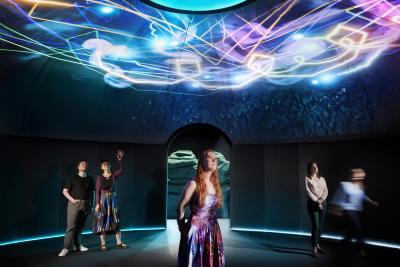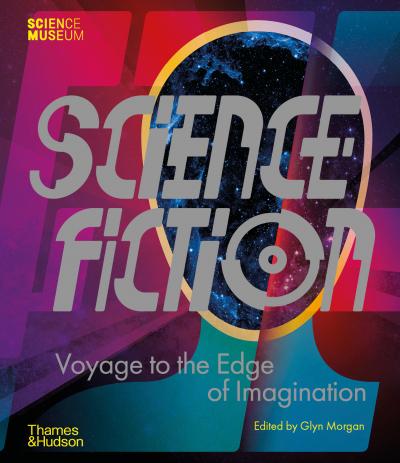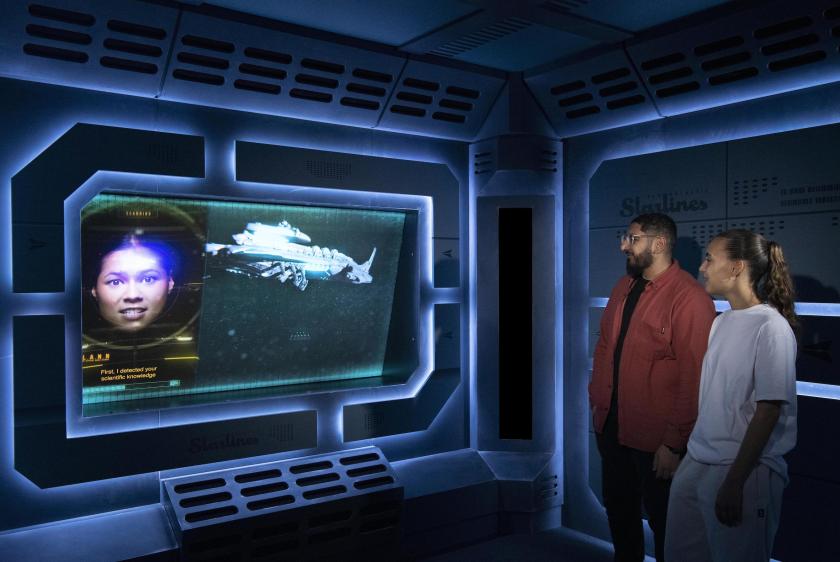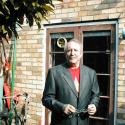Scenes that stay in the mind: Arnold Schwarzenegger as the Terminator peeling back the skin on his forearm to reveal the gleaming machinery within; a beady-eyed, new-born Alien bursting from John Hurt’s abdomen; that all-species bar in Star Wars; the spaceship’s long-awaited descent in Close Encounters.
You probably have your own selection, from films, from computer games or, perhaps, from Disneyland’s 14-acre Star Wars themed park-within-a-park in California, Galaxy’s Edge. Science fiction, once a minority sport, has been mainstreamed in recent decades via popular media – and above all by blockbuster movies.
This is where the glitzy new exhibition at the Science Museum in London gets its main inspiration. Which put the designers in a bit of a fix. Their show, for show it is, is built around a journey on an interstellar ship, guided by an AI built by aliens. It takes in plenty of movie props, along with bits of real tech. And they are augmented by chunks of exposition, comments and asides from the AI’s avatar – on distinctly un-science-fictional video screens.
 It is all very colourful, but doesn’t quite achieve the impression intended. A largely static exhibition, however lovingly designed and mounted, can’t match the experience of a movie. And the focus on a predictable selection of films and TV shows means this collection of snapshots from strange new worlds seems oddly familiar. The heart of the matter, though, is that making the exhibition a pendant to films dictates a fixation on the visual. It turns out that visual realisations reach “the edge of the imagination” rather quickly. The explosion of visual representations has taken the geeky, pulp-derived genre of science fiction into the wider culture, but has done it in a curiously constrained way.
It is all very colourful, but doesn’t quite achieve the impression intended. A largely static exhibition, however lovingly designed and mounted, can’t match the experience of a movie. And the focus on a predictable selection of films and TV shows means this collection of snapshots from strange new worlds seems oddly familiar. The heart of the matter, though, is that making the exhibition a pendant to films dictates a fixation on the visual. It turns out that visual realisations reach “the edge of the imagination” rather quickly. The explosion of visual representations has taken the geeky, pulp-derived genre of science fiction into the wider culture, but has done it in a curiously constrained way.
You can see why in the excellent accompanying book, edited by exhibition curator Glyn Morgan. It’s a Thames & Hudson production, so it’s lavishly illustrated, but the images remind you that it is extremely hard to imagine something genuinely new that is visually intelligible. Consider how almost all cinematic aliens are recognisably derived from existing or extinct Earth species, mixed and matched, perhaps, but also familiar. The genuinely alien aliens, such as whatever dwells in the intelligent ocean in Solaris, are beyond depiction. Writers can suggest them without really describing them. Film-makers rarely get away without showing them.
A further problem for the exhibition is that even the best images need exposition. Sometimes, as with the artworks from the extraordinary Radical Ocean Futures project, it is simply absent – images that are normally presented with a lot of narrative exposition are abstracted, and left high and dry. Sometimes, there is more to learn from the videos, as from the remarkable double amputee Tilley Lockey talking about her bionic arms. Either way, it leaves the impression of an exhibition that wants to be a website.
The journey through the displays, which takes in a surprising amount of blank corridors and extensive signage (in a specially created, unintelligible alien language), leads the visitor to the inevitable question of whether we who have created all these stories actually have a future. “The choices your species have made are endangering your ecosystems”, the AI explains cheerily: a message that has been spelled out in films for at least half a century since Silent Running. The verdict is guardedly optimistic, but it makes for a somewhat downbeat ending to a mildly diverting if underwhelming hour. The book cannot present life-size space suits, or alien models, but the other affordances of print more than make up for it. More spectacular modern media may grab the attention, yet it has always been print that supports the rich soil of ideas that science fiction narratives grow from – as London’s last big show about the genre a decade ago at the British Library explored. The book brings together essays by academics and critics with interviews with a few well-chosen authors, and is able to draw on written science fiction, and its history, in a way that gives it much broader scope than the exhibition.
The book cannot present life-size space suits, or alien models, but the other affordances of print more than make up for it. More spectacular modern media may grab the attention, yet it has always been print that supports the rich soil of ideas that science fiction narratives grow from – as London’s last big show about the genre a decade ago at the British Library explored. The book brings together essays by academics and critics with interviews with a few well-chosen authors, and is able to draw on written science fiction, and its history, in a way that gives it much broader scope than the exhibition.
It is not comprehensive. The genre is too big and baggy to allow that. Still, it treats its selected themes – people and machines, travelling the cosmos, communication, aliens, and hopes and fears for the future – well. There is an emphasis on science fiction’s subversive potential, particularly from some of the writers now energising the genre. As Charlie Jane Anders puts it, “power structures try and trick us into believing they are both permanent and unassailable, and only by creating and consuming stories that are wildly different can we start to imagine how those structures could change or crumble.”
 That’s one aspect of editor Morgan’s larger suggestion that science fiction is a way of thinking about our relationship with the future. It is a lot of other things too, but the importance of that possibility comes across clearly. It is there in the mutual inspiration of real and fictional invention that Roger Luckhurst describes in his essay on communication, where “advanced technology, shameless boosterism, investor pitches, futurological projections and science fiction deliriously cross-fertilise one another.” And it’s there in the closing interview with Kim Stanley Robinson, looking back at an entire career creating near-future fictions that take global problems seriously but still manage to conjure liveable worlds. This is one of the points where book and exhibition come together, but the book stands well alone. It’s an excellent guide to the importance of science fiction for complete beginners, and has plenty to interest the genre buff, or just the reader who has enjoyed science fiction on film but wants to explore the most resonant ideas and stories a bit more thoroughly. In any case, it is good it will have a life beyond the displays at the Science Museum. As an exploration of the limits of imagination it goes a lot further, and is more thought-provoking, than the exhibition.
That’s one aspect of editor Morgan’s larger suggestion that science fiction is a way of thinking about our relationship with the future. It is a lot of other things too, but the importance of that possibility comes across clearly. It is there in the mutual inspiration of real and fictional invention that Roger Luckhurst describes in his essay on communication, where “advanced technology, shameless boosterism, investor pitches, futurological projections and science fiction deliriously cross-fertilise one another.” And it’s there in the closing interview with Kim Stanley Robinson, looking back at an entire career creating near-future fictions that take global problems seriously but still manage to conjure liveable worlds. This is one of the points where book and exhibition come together, but the book stands well alone. It’s an excellent guide to the importance of science fiction for complete beginners, and has plenty to interest the genre buff, or just the reader who has enjoyed science fiction on film but wants to explore the most resonant ideas and stories a bit more thoroughly. In any case, it is good it will have a life beyond the displays at the Science Museum. As an exploration of the limits of imagination it goes a lot further, and is more thought-provoking, than the exhibition.
- Science Fiction: Voyage to the Edge of the Imagination at the Science Museum until 4 May 2023
- Science Fiction: Voyage to the Edge of the Imagination edited by Glyn Morgan (Science Museum/Thames & Hudson, £30.00)















Add comment